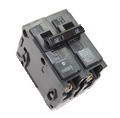House Wiring and Electrical Circuit Applications |
|
|
|
Garage Sub-Panel - 4-Wire FeedI connected a 60 amp sub panel in my garage,I used underground wire rate 600 volts, which has BX cable covered. I have connected the red and black as main power.the blue wire is taped white,connected to the left side of the grounding bar, and bare wire to the right side,I would like to know if this matters with the bare wire to ground,everything seems to be working fine, no breakers are getting warm , and I tripped a breaker to be sure all is working,your help in this matter would be appreciated, Thank you AL. Al, this looks good with one exception. Because this is a sub-panel it requires a 4-wire circuit feed with a dedicated neutral and a dedicated ground, with termination of each going to separate terminals strips or terminal bars. The neutral terminal strip is not connected to the ground at this sub-panel location and is dedicated for neutrals only. The ground wire gets terminated to a separate ground terminal strip that IS connected or bonded to the sub-panel enclosure and is dedicated for ground wires only. The ground wire and neutral wires can be terminated together ONLY at the Main Electrical Panel. |
» Circuit Breakers and Fuses
» Need Electrical Help? Ask the Electrician
Basic House Wiring Circuits and Circuit Breakers

|
Summary: This article looks at common 120 volt and 240 volt house wiring circuits and the circuit breakers that are installed identifying the types and amperage sizes used in most homes.
© By: Dave Rongey |
Electrical Circuits and Circuit Breakers for House Wiring
The electrical circuit breakers serving your home wiring circuits are intended for switching and protection of your home's wiring from high temperatures caused by excess current higher than the rating of the wire.
While thermal-magnetic circuit breakers are the key element for overload and short-circuit protection of your electrical system, there are potentially dangerous conditions that do not involve over-current.
The following electrical circuit breakers should be utilized to provide further protection.
Basic House Wiring Circuits |
||
 |
||
| Lighting | Living Room Kitchen |
|
| General Purpose Outlets | Living Rooms Den Library Office |
|
 |
||
| 120 volt appliance outlets | Kitchen |
|
 |
||
| Large Appliances | Electric Clothes Dryer Electric Water Heater Air Conditioners Stove Range |
|
| The size of the circuit breaker will depend on the required circuit as specified in the equipment installation manual. | ||
 |
||
| General Purpose Outlets | Bedrooms | |
| Required for bedroom circuits and other areas as specified by the NEC Codes which have been adopted in the specific county or state. | ||
|
The Safest Way to Test Electrical Devices and Identify Electric Wires!The Non-Contact Electrical TesterThis is a testing tool that I have had in my personal electrical tool pouch for years, and is the first test tool I grab to help identify electrical wiring. It is a Non-contact tester that I use to easily Detect Voltage in Cables, Cords, Circuit Breakers, Lighting Fixtures, Switches, Outlets and Wires. Simply insert the end of the tester into an outlet, lamp socket, or hold the end of the tester against the wire you wish to test. Very handy and easy to use.
The Quickest Way to Check for Faulty Electrical Wiring!The Plug-In Outlet TesterThis is the first tool I grab to troubleshoot a problem with outlet circuit wiring. This popular tester is also used by most inspectors to test for power and check the polarity of circuit wiring. It detects probable improper wiring conditions in standard 110-125 VAC outlets Provides 6 probable wiring conditions that are quick and easy to read for ultimate efficiency Lights indicate if wiring is correct and indicator light chart is included Tests standard 3-wire outlets UL Listed Light indicates if wiring is incorrect Very handy and easy to use.
Strip Off Wire Insulation without Nicking and Damaging the Electric Wire!The Wire Stripper and Wire CutterMy absolute favorite wire stripping tool that I have had in my personal electrical tool pouch for years, and this is the tool I use to safely strip electrical wires. This handy tool has multiple uses: The wire gauges are shown on the side of the tool so you know which slot to use for stripping insulation. The end of the tool can be used to grip and bend wire which is handy for attaching wire onto the screw terminals of switches and outlets.. The wire stripper will work on both solid and stranded wire. This tool is Very Handy and Easy to Use. |
||
Residential Electrical Parts and AccessoriesLight Switches 120volt Outlets Circuit Breakers Electrician Tools Voltage Testers |














